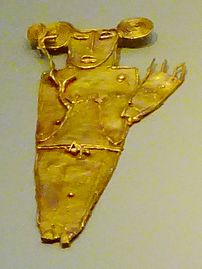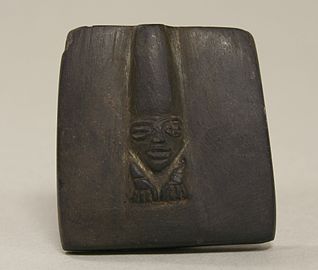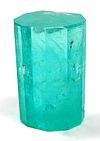Tunjo





A tunjo (from
Background
The Muisca, organised in their loose
Description
Tunjos were small figures picturing people, the deities of the Muisca religion or animals. They were used for three purposes; as ornaments in the graves of the Muisca people, from various social classes, as decoration at the entrances of temples and shrines, which once filled were buried in secret places by the Muisca priests and as offer ritual figures in the sacred lakes and rivers of the Muisca.[5]
Tunjos have been uncovered in
Fabrication
The Muisca used to make matrixes or moulds of rock types such as shales and obsidian and poured their molten gold or tumbaga into the matrix. When the metals were cooled and solidified, they removed the stone moulds and the tunjos remained.[5] To create the 2D tunjos, they used a lost-wax casting process using beeswax to make the figure, put the wax tunjo in clay, that was heated to evaporate the wax and the gold or tumbaga was poured into the empty space left.[8]
The design of the majority of tunjos appears to have gold wire soldered or brazed onto their surface. This, however, is not the case and analysis of the dendrites formed in the metal has shown that they have in fact been cast as one piece.
Alloys
Various tunjos have been analysed with X-ray fluorescence (XRF) giving the following results:[5][9]
| metal | 1 | 2 | 3 | 4 | 5 | 6 | 7 | 8 | #2 | #8 |
|---|---|---|---|---|---|---|---|---|---|---|
| gold | 71.54 | 79.48 | 96.90 | 88.64 | 88.72 | 81.10 | 86.72 | 85.62 | 54.63 | 45.91 |
| silver | 23.67 | 18.01 | 2.48 | 11.05 | 10.02 | 12.18 | 12.79 | 12.79 | 16.31 | 10.55 |
| copper | 4.62 | 2.48 | traces | 0.12 | 1.11 | 5.94 | 1.16 | 1.47 | 29.31 | 43.70 |
| lead | traces | 0.28 | traces | |||||||
| iron | 0.02 | |||||||||
Museum collections
Of the relatively few Muisca artefacts that can be found in museums outside of Colombia, the tunjos are most common. Tunjos are in the collections of the
Trivia
- the largest Colombian beer brand Club Colombia uses a tunjo in their symbolism.
Gallery
-
Tunjo, Museo del Oro, Bogotá
-
Tunjo, Museo del Oro
-
Tunjo, Museo del Oro
-
Tunjo, MET
-
Mold for tunjo production, MET
See also
- Muisca art
- Muisca economy
- Gold Museum, Bogotá, the largest collection of tunjos and other indigenous Colombian golden art
- Muisca religion
- Sumapaz Paramo, named after the tunjos
- Muisca
References
- ^ (in Spanish) chunso - Muysccubun Dictionary
- ^ a b c (in Spanish) Tunjos on Arte en la red
- ^ Ocampo López, 2007, Ch.V, p.188
- ^ (in Spanish) Tunjos and other Muisca art - Pueblos Originarios
- ^ a b c d (in Spanish) Description and metallurgy of tunjos - Museo del Oro - Bogotá
- ^ (in Spanish) Tunjos found in caves and other places
- ^ (in Spanish) Tunjo of the Pijao people
- ^ Cooper, 2013
- ^ Poster at the Museo del Oro, Bogotá
- ^ Tunjo in American Museum of Natural History
- ^ Tunjos in the Art Institute Chicago
- ^ Tunjos in the Baltimore Museum of Art
- ^ Tunjo in the British Museum
- ^ Tunjo in the Brooklyn Museum
- ^ Tunjos in the Cleveland Art Museum
- ^ Tunjos in the Dallas Museum of Art
- ^ Tunjo in Hunt Museum
- ^ Tunjos in the Metropolitan Museum of Art
- ^ Tunjos in the Museum of Fine Arts, Houston Archived 2016-07-01 at the Wayback Machine
- ^ Tunjo in the Princeton University Art Museum
- ^ Tunjo in the Smithsonian National Museum of the American Indian
Bibliography
- Cooper, Jago. 2013. The Lost Kingdoms of South America - Episode 3 - Lands of Gold. Accessed 2016-07-14.
- Ocampo López, Javier. 2007. Grandes culturas indígenas de América - Great indigenous cultures of the Americas, 1–238. Plaza & Janes Editores Colombia S.A..







